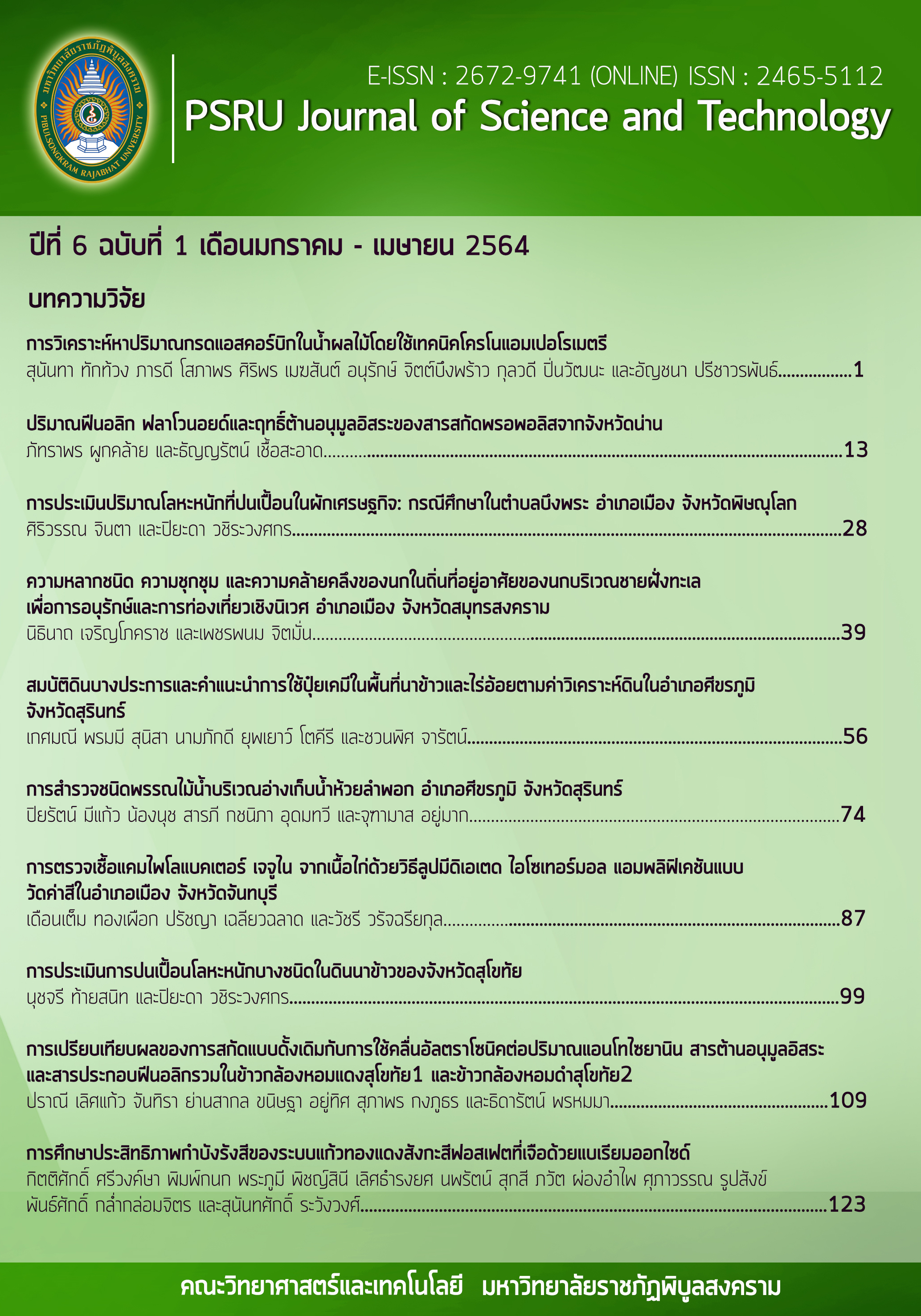COMPARISON OF TRADITIONAL AND ULTRASONIC-ASSISTED EXTRACTION METHODS ON ANTHOCYANIN, TOTAL PHENOLIC COMPOUNDS AND ANTIOXIDANT ACTIVITY OF HOMDAENG ST.1 AND HOMDUM ST.2 BROWN RICE
Keywords:
Anthocyanin, Antioxidant, Phenolic compounds, Brown rice, UltrasonicAbstract
Variety of bioactive compounds with health benefits have been discovered in pigmented rice. This research aims to study the effects of extraction methods on biological active compounds of Homdaeng ST.1 and Homdum ST.2 brown rice. Both types of brown rice were extracted using conventional and ultrasonic-assisted extraction techniques to examine the most effective method of extracting their active compounds. The ultrasonic extraction method of Homdum ST.2 extract provided the highest yield of 2.45%, while traditional extraction method of Homdaeng ST.1 extract gave the lowest value amounted of 1.06%. Anthocyanin content was determined by pH-differential method. Antioxidant capacity was measured by DPPH method and total phenolic compounds were evaluated by Folin–Ciocalteu colorimetric. It was found that the ultrasonic extraction method of Homdum ST.2 exhibited the highest anthocyanin content of 9.128 mg/L. However, the highest antioxidant activity was shown in traditional extraction method of Homdaeng ST.1, exhibiting 201.556 µg BHT/ml, and IC50 value of 12.089 µg /ml. Moreover, the traditional method of Homdaeng ST.1 exhibited the highest total phenolic compound of 149.98 mg GAE/g extract. The findings of this study might help in considering the type of extraction techniques for Homdaeng ST.1 and Homdum ST.2 brown rice to be used as ingredients in supplements, as well as in functional foods.
References
กิตติพัฒน์ โสภิตธรรมคุณ, และปานทิพย์ รัตนศิลป์กัลชาญ. (2560). การสกัดและวิธีวัดความสามารถการต้านอนุมูลอิสระในพืชสมุนไพร. วารสารวิทยาศาสตร์และเทคโนโลยี หัวเฉียวเฉลิมพระเกียรติ, 3(1), 86-94.
เฉลิม จันทร์สม, สกุล มูลคำ, วนิดา จันทร์สม, เอกสิทธิ์ สกุลคู, และกรณ์กาญจน์ ภมรประวัติธนะ. (2553). ฤทธิ์ต้านออกซิเดชันและองค์ประกอบทางเคมีของข้าวเหนียวก่ำพันธุ์พื้นเมือง. ธรรมศาสตร์เวชสาร, 12(2), 136-143.
ดวงกมล เรือนงาม. (2557). การสกัดสารต้านอนุมูลอิสระ. วารสารวิทยาศาสตร์ลาดกระบัง, 23(2), 120-139.
นพวรรณ ชิราวัธน์, วิภาพร เกิดช่าง, สิบสองเมษา สามงามเขียว, และธิดารัตน์ พรหมมา. (2560). การศึกษาปริมาณแอนโทไซยานินในข้าวกล้องหอมดำสุโขทัย2 ข้าวกล้องหอมแดงสุโขทัย1 และข้าวดอกข่า. ใน การประชุมทางวิชาการระดับชาติ ครั้งที่ 4 (น. 1031-1034) กำแพงเพชร: มหาวิทยาลัยราชภัฏกำแพงเพชร.
พิชญอร ไหมสุทธิสกุล, และลดาวัลย์ ช่างชุบ. (2555). ปริมาณฟีนอลิกทั้งหมด แอนโธไซยานิน กิจกรรมต้านอนุมูลอิสระ สีและสเปกตรัมในช่วงที่สามารถมองเห็นได้ของข้าวไทย 9 สายพันธุ์และความสัมพันธ์. ใน การประชุมทางวิชาการของมหาวิทยาลัยเกษตรศาสตร์ ครั้งที่ 50 (น. 113-121) กรุงเทพฯ: มหาวิทยาลัยเกษตรศาสตร์.
รัตนา ม่วงรัตน์, กรรณิการ์ เรือนหล้า, และธัญชนก กันทวงศ์. (2560). ปัจจัยที่มีผลต่อสารแอนโธไซยานินที่สกัดได้จากเมล็ดแห้งข้าวโพดข้าวเหนียวสีม่วงด้วยเทคนิคการสกัดด้วยน้ำที่สภาวะต่ำกว่าจุดวิกฤติและฤทธิ์ต้านอนุมูลอิสระของสารสกัด. วารสารเกษตร, 33(1), 141–151.
ราตรี พุฒิสาร, และประภาศรี ภูวเสถียร. (2536). ข้าวกล้อง. สืบค้น 13 พฤศจิกายน 2562, จาก https://www.doctor.or.th/article/detail/3525?fbclid
วโรทัย โกศลพิศิษฐ์กุล. (2551). ปีทองของข้าวไทย. สืบค้น 13 พฤศจิกายน 2562, จาก http://www2.fpo.go.th/S-I/Source/Article/Article79
วิลัดดา สินทร, วรัญญา จตุพรประเสริฐ, มาลิน จุลศิริ, และกนกวรรณ จารุกำจร. (2557). ศักยภาพการต้านอนุมูลอิสระในหลอดทดลองของข้าวสีพันธุ์ไทย. วารสารเภสัชศาสตร์อีสาน, 9 (ฉบับพิเศษ), 164.
ศิรินาถ เที่ยงธรรม. (2556). การสกัดสารต้านอนุมูลอิสระจากกากองุ่นแดงด้วยวิธีการช่วยสกัดด้วยอัลตร้าโซนิก. (วิทยานิพนธ์ปริญญามหาบัณฑิต), สถาบันเทคโนโลยีพระจอมเกล้าเจ้าคุณทหารลาดกระบัง. กรุงเทพฯ.
อรัญญา พรหมกูล, วรัญญา วงศ์ไชยสิทธิ์, ไอรดา อักษ์เสน, และเกรียงไกร พัทยากร. (2558). การใช้คลื่นอัลตร้าโซนิคในการสกัดแอนโทไซยานินจากกากเม่า. แก่นเกษตร, 43(1), 830-835.
อเนก หาลี, และบุณยกฤต รัตนพันธ์. (2560). การศึกษาประสิทธิภาพในการต้านอนุมูลอิสระจากพืชผักสมุนไพรพื้นบ้าน 15 ชนิด. วารสารวิจัยและพัฒนา มจธ, 40(2), 283-293.
อารีรัตน์ ซื่อดี. (2560). การใช้คลื่นไมโครเวฟสกัดสารสำคัญจากพืชสมุนไพร. วารสารวิชาการมหาวิทยาลัยอีสเทิร์นเอเชีย ฉบับวิทยาศาสตร์และเทคโนโลยี, 11(1), 1-14.
Carla, D.P., Erica, P., & Deborha, D. (2012). Comparison of ultrasound-assisted extraction with conventional extraction methods of oil and polyphenols from grape (Vitis vinifera L.) seeds. Ultrasonics Sonochemistry, 20(4), 1076-1080.
Hielscher ultrasonics gmbh. (2019). เทคโนโลยีอัลตราซาวนด์ Hielscher. สืบค้น 13 พฤศจิกายน 2562, จาก https://www.hielscher.com/th/ultrasonic-extraction-of-ayurvedic-herbs.htm
Peanparkdee, M., Patrawart, J., & Iwamoto, S. (2019). Effect of extraction conditions on phenolic content, anthocyanin content and antioxidant activity of bran extracts from Thai rice cultivars. Journal of Cereal Science, 86(1), 86-91.
Porto, C.D., & Decorti, D. (2009). Ultrasound-assisted extraction coupled with under vacuum distillation of flavor compounds from spearmint (carvone-rich) plants: Comparison with conventional hydrodistallation. Ultrasonics Sonochemistry, 16(1), 795-799.
Shao, Y., Xu, F., Sun, X., Bao, J., & Beta, T. (2014). Phenolic acids, anthocyanin, and antioxidant capacity in rice (Oryza sativa L.) grains at four stages of development after flowering. Food Chemistry, 143(1), 90-96.
Shuang Ma., Xu Yang., Cuin Wang., & Mingruo Guo. (2018). Effect of ultrasound treatment on antioxidant activity and structure of β-Lactoglobulin using the Box–Behnken design. CyTA-Journal of Food, 16(1), 596-606.
Tao, Y., Wu, D., Zhang, Q.A., & Sun, D.W. (2014). Ultrasound-assisted Extraction of Phenolics from Wine Lees: Modeling Optimization and Stability of Extracts during Storage. Ultrasonics Sonochemistry, 21(2), 706-715.
Valero, M., Recrosio, N., Saura, D., Martic, N., & Lizama, V. (2007). Effects of ultrasonic treatments in orange juice processing. Journal of Food Engineering, 80(1), 509-516.
Vitkhu, K., Mawson, R., Simons, L., & Bates, D. (2008). Applications and opportunities for ultrasound assisted extraction in the food industry - A review. Innovative Food Science and Emerging Technologies, 9(1), 161-169.
Yaqin, M., Xingqian, Ye., Yunbin,Hao., Guoneng, Xu., Guihua, Xu., & Donghong, Liu. (2008). Ultrasound-assisted extraction of hesperidin from Penggan (Citrus reticulata) peel. Ultrasonics Sonochemistry, 15(1), 227–232.
Downloads
Published
How to Cite
Issue
Section
License
กองบรรณาธิการขอสงวนสิทธิ์ในการปรับปรุงแก้ไขตัวอักษรและคำสะกดต่างๆ ที่ไม่ถูกต้อง และต้นฉบับที่ได้รับการตีพิมพ์ในวารสาร PSRU Journal of Science and Technology ถือเป็นกรรมสิทธิ์ของคณะวิทยาศาสตร์และเทคโนโลยี มหาวิทยาลัยราชภัฏพิบูลสงคราม และ
ผลการพิจารณาคัดเลือกบทความตีพิมพ์ในวารสารให้ถือมติของกองบรรณาธิการเป็นที่สิ้นสุด







